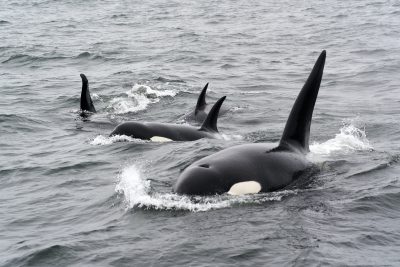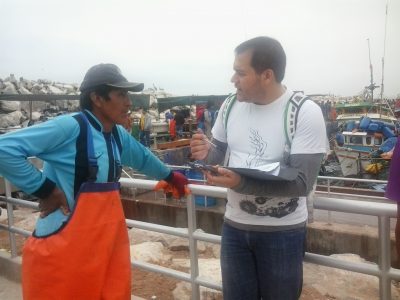 At the heart of the Global Ocean Modelling (GOM) research unit at the Institute for the Oceans and Fisheries (IOF) is Ecopath with Ecosim, an ecological modelling software suite nurtured and developed into its current form by IOF professors Villy Christensen and Carl Walters. Named by the National Ocean and Atmospheric Administration as one of the 10 biggest scientific breakthroughs of the last 200 years and adopted by scientists around the world in hundreds of studies, Ecopath has, without hyperbole, revolutionized scientists’ understanding of marine ecosystems. Over 30 years into its development, researchers are still finding new ways to apply Ecopath to their research questions – and the GOM is leading this exploration.
At the heart of the Global Ocean Modelling (GOM) research unit at the Institute for the Oceans and Fisheries (IOF) is Ecopath with Ecosim, an ecological modelling software suite nurtured and developed into its current form by IOF professors Villy Christensen and Carl Walters. Named by the National Ocean and Atmospheric Administration as one of the 10 biggest scientific breakthroughs of the last 200 years and adopted by scientists around the world in hundreds of studies, Ecopath has, without hyperbole, revolutionized scientists’ understanding of marine ecosystems. Over 30 years into its development, researchers are still finding new ways to apply Ecopath to their research questions – and the GOM is leading this exploration.
Ecopath uses data to create simulations that make predictions and draw inferences about the ways that human developments and environmental shifts like climate change will impact life in the ocean.
“It’s an incredibly flexible approach, way beyond what people realize by reading a few papers and opening the software,” said Villy Christensen, University of British Columbia (UBC) professor and principal investigator of the GOM.
One project that Christensen is particularly excited about is the GOM’s partnership with the Tsleil-Waututh Nation, whose leaders approached the GOM for assistance in detailing the baseline environmental conditions of the Burrard Inlet as well as developing a model of what the inlet’s marine ecosystem would have looked like before colonization. The project, through the work of PhD candidate Meaghan Efford, combines the use of traditional ecological knowledge – or Indigenous knowledge – with archaeology and ecosystem modelling using Ecopath and will help inform decisions about development in the inlet.
“The Port of Metro Vancouver are using the same approach for one of their projects,” Christensen said. “That means when the next development comes in this area, it will involve Tsleil-Waututh, and the port and Tsleil-Waututh can talk the same language. They both understand the approaches for evaluating this.”
The project has unearthed an ecosystem that looks very different from the one people living in the Lower Mainland are used to seeing today — one with 50% more intertidal area and with much higher seafood production.
“Every time I see this ecosystem, I can’t help seeing how it looked 200 years ago. And that’s so fascinating here in your own hometown,” Christensen said.
GOM researchers use modelling to answer questions about animals and people

Photo by Mike Doherty on Unsplash
A culturally important animal for many coastal First Nations and a source of tourism revenue, southern resident killer whales now number only 74 members due to food limitation and human interference with their habitats.
“Sometimes I ask myself the question, ‘Is it possible that the southern resident killer whale population was always at such low levels and will just go extinct?’”, Couture said. “I hope my research will answer this question.”

Santiago de la Puente interviews a Peruvian jumbo squid fisher (Photo: Rocío López de la Lama)
De la Puente is modelling the Peruvian fisheries sector in order to help make the industry, which has some of the best fishing in the world, but where one in four children in the country are malnourished, more equitable and sustainable. The work involves collecting data about small-scale and large-scale fisheries as well as the amounts of money exchanged as fish move from the ocean to the dinner table.
“I can follow that value chain and I know in each part of the chain how many people are employed, how much money they’re making,” de la Puente said. “Politicians could care less about two more tonnes of whatever in the water, but they do care about a 20 per cent job reduction or increasing the contribution to food security in this country by x percent. This allows us to change the narrative. We add a new set of indicators that are in the same language that decision-makers use.”
COVID-19 brings Ecopath instruction to a bigger audience
The COVID-19 pandemic has halted progress for many university departments across Canada. However, it has created an opportunity for the GOM.
When the IOF’s ecosystem modelling class (FISH 501) moved online, Christensen opened the course to interested researchers from across the globe, something that could never have happened when classes were held only on UBC campus.
Researchers from 29 countries who aren’t students at the IOF are enrolled in the course and are learning to use Ecopath. Exporting Ecopath around the world and making it freely accessible have been a driving ambition for Christensen since he began work on it over 25 years ago.
“We’re still very much in the act of educating people about this approach. That’s really what it’s about, it’s training good scientists,” he said. “For me that’s been one of the rewarding things – to find good colleagues around the world who are engaging to work with irrespective of background and nationality.”
Tags: British Columbia, Ecopath, Ecopath with Ecosim (EWE), faculty, Global Ocean Modelling, IOF students, killer whales, Modelling, Peru, Research, Tsleil-Waututh Nation, Villy Christensen, whales